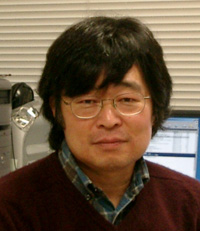We are testing a new system for linking grants to scientists.
The funding information displayed below comes from the
NIH Research Portfolio Online Reporting Tools and the
NSF Award Database.
The grant data on this page is limited to grants awarded in the United States and is thus partial. It can nonetheless be used to understand how funding patterns influence mentorship networks and vice-versa, which has deep implications on how research is done.
You can help! If you notice any innacuracies, please
sign in and mark grants as correct or incorrect matches.
Sign in to see low-probability grants and correct any errors in linkage between grants and researchers.
High-probability grants
According to our matching algorithm, Izumi Ohzawa is the likely recipient of the following grants.
| Years |
Recipients |
Code |
Title / Keywords |
Matching
score |
| 1999 — 2000 |
Ohzawa, Izumi |
R01Activity Code Description:
To support a discrete, specified, circumscribed project to be performed by the named investigator(s) in an area representing his or her specific interest and competencies. |
Neural Basis of Monocular and Binocular Texture Analysis @ University of California Berkeley
The long-term objective of this research is to determine how the visual part of the cerebral cortex analyzes information that enter through the two eyes, and transforms it into a form useful for perception. The proposed project approaches the problem of visual information processing using electrophysiological recording methods combined with elaborate visual stimulation and analysis techniques. The methods are applied to the problem of how cortical neurons analyze visual texture information and integrate it with that from brightness cues. A hypothesis is proposed that texture-sensitive neurons represent third and fourth stages of hierarchical processing in the visual cortex. To test this hypothesis, a cascaded model of texture cells is constructed based on the notion of "texture receptive field." The following specific aims will be addressed. (1) A model of texture cells will be developed based on a cascaded organization in which the identical neural computation is performed twice serially. Computational studies will examine how well this model predicts known properties of texture perception and cell responses. (2) The cascade model will be tested neurophysiologically by measuring texture receptive fields of visual neurons and comparing them to predictions of the model. Specific neural connections predicted by the model will be sought by analyzing activities of simultaneously recorded groups of neurons. (3) Neural responses to mixed texture and brightness-defined stimuli will be studied to determine how texture neurons integrate these two cues. (4) By stimulating texture neurons simultaneously through the two eyes, the roles that texture information plays in binocular vision and stereopsis will be examined. (5) Developmental time course of neural texture responses will be studied in young animals. These studies will yield a functional schematic diagram of the texture- brightness processing pathway of the visual cortex. Such detailed description of the brain circuitry will be valuable in diagnosing and understanding visual disorders.
|
0.966 |
